Total Shareholder Return (TSR) is a critical metric that captures the total returns an investor receives from a particular stock. TSR factors in dividend payments, capital gains, and earnings reinvested into the purchase of additional shares.
It stands as one of the most comprehensive tools for assessing a company’s performance through an investor’s lens. Let’s learn what is TSR In finance.
The Components of TSR
TSR is a combination of gains from dividends and stock price appreciation. Dividends are periodic payments made to shareholders out of a company’s profits. These payments contribute to TSR when they are reinvested to purchase more shares.
Capital gains arise when the sold stock price is higher than the purchase price, reflecting the increased value of the company.
In some cases, share repurchases, where the company buys back its own shares, leading to a rise in the value of remaining shares, are also considered part of TSR. These elements jointly reflect the true return to shareholders.

Calculation of TSR
TSR is calculated by adding the sum of dividend payouts and the difference between the end and start stock price, and then dividing this by the starting stock price. This is then typically expressed as a percentage to indicate the total return on investment.
An illustrative example with actual numbers helps to clarify this computation. As dividends play an instrumental role, factoring in their reinvestment is pivotal to obtaining an accurate TSR.
TSR vs. Other Performance Metrics
Comparing TSR to other financial indicators, like stock price alone, underscores its comprehensive nature. Sole reliance on stock price changes can offer an incomplete picture because it ignores dividends, which might constitute a significant portion of returns.
Moving to earnings-based metrics, such as Earnings Per Share (EPS) and the Price-to-Earnings (P/E) ratio, which assess profitability and valuation, it’s crucial to understand their limitations. TSR includes actual returns received by the shareholders, whereas EPS or P/E doesn’t. An emphasis on using multiple metrics ensures a more rounded view of a company’s performance.
In relation to Return on Equity (ROE) and Return on Assets (ROA), TSR differs as these focus on profitability relative to equity and assets, respectively. These metrics don’t translate directly to realized shareholder returns, highlighting the distinct insight provided by TSR.
What Is TSR In Finance?
In the arena of company valuation, TSR is invaluable as it encapsulates the investor’s perspective. Historical TSR helps forecast future returns. This aspect is especially relevant to investor relations and stock market analysts who track performance over time.
Executive compensation packages often tie to TSR, reflecting a company’s financial health through its stock performance. The performance incentives related to TSR can be both beneficial and contentious, depending on how well they align with long-term company goals.
For investment decisions, particularly in portfolio management, TSR’s comprehensive outlook aids in identifying attractive investment opportunities and in deciding whether to hold or sell current investments.

Pros and Cons of TSR
TSR is lauded for encompassing a total picture of shareholder value creation, such as accounting for long-term performance.
However, it can be skewed by external market dynamics not necessarily tied to company operations. One has to be cautious; TSR does not always mirror operational efficiency.
Best Practices for Utilizing TSR
A balanced scorecard that includes TSR along with several other key performance indicators is wise. Peer comparison is valuable, and it is prudent to compare TSR across similar time frames to understand growth patterns adequately.
Frequently Asked Questions
What is the difference between absolute and relative TSR?
Absolute TSR measures the total returns of a stock independently, focusing on dividends, stock price appreciation, and reinvestment returns. Relative TSR compares these total returns against a benchmark or peer group to understand the stock’s performance in the broader market context.
How does TSR account for stock splits and dividends?
TSR accounts for stock splits by adjusting the stock price so that the split doesn’t artificially affect the calculation. For dividends, TSR includes them as part of the total returns, often assuming dividends are reinvested into the purchase of more shares, thus affecting the shareholder’s total investment return.
Can TSR be negative, and what does it signify?
Yes, TSR can be negative, signifying that the total return on the investment was a loss. This loss can result from a decrease in stock price, dividends not offsetting the price loss, or both, indicating poor company performance or adverse market conditions during the period.
How do changing interest rates affect TSR?
Changing interest rates can affect TSR indirectly through their impact on stock prices and company profitability. Rising rates can increase borrowing costs, potentially lowering profits and stock prices. Conversely, falling rates can stimulate investment and stock market gains, positively impacting TSR.
Why is TSR important for investors to understand before making investment decisions?
TSR is crucial for investors because it offers a comprehensive view of potential investment returns, including dividends and stock price appreciation. Understanding TSR enables investors to assess past performance, compare investment opportunities, and make informed decisions based on total return potential rather than price changes alone.
Conclusion
TSR is foundational in evaluating the financial health of a company, but should be considered in concert with other metrics for a full picture. This recap underlines the article’s core theme—TSR as a vital, yet one of many, tools in financial analysis.


 Tags:
Tags:










